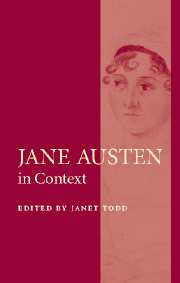37 - Reading Practices
Published online by Cambridge University Press: 19 December 2020
Summary
Toward the end of the eighteenth century, England experienced a literacy crisis, though not one brought on by an appreciable spike in the number of readers. Literacy rates climbed gradually from the middle of the seventeenth century to the last decades of the nineteenth, when something close to universal literacy was finally reached. But during the period of Jane Austen's girlhood and youth – the 1780s and 1790s – the incremental growth of reading proficiency across classes and among both men and women became noticeable enough to inspire a host of pronouncements, some congratulatory, others dire. For a bookseller like James Lackington, it could only be a cause for celebration that ‘all ranks and degrees now read’, while the reactionary Anti-Jacobin Review provided a ready outlet for grimmer remarks: ‘Those taught to read, to write, to reason, we now see grasping with curiosity every pernicious treatise within reach.’ Although probably not much more than half of lower-class males were literate by the turn of the nineteenth century, Samuel Taylor Coleridge, his radical youth now far behind him, could worry in The Statesman's Manual (1816) that ‘Books are in every hovel. The Infant's cries are hushed with picture-books – and the Cottager's child sheds his first bitter tears over pages, which render it impossible for the man to be treated or governed as a child.’ For Coleridge, however, as for a wide spectrum of liberal and conservative reformers, the only way forward was not to extinguish, but to manage the rise of literacy: ‘Here as in so many other cases, the inconveniences that have arisen from a thing's having become too general, are best removed by making it universal.’ If Austen's era can rightly be seen as an age of educational innovation, expansion and reform, this may well owe less to benevolent impulses to spread literacy than to anxious schemes for controlling it.
In relation to the ever-growing number of women readers – and writers – over the course of Austen's lifetime, anxieties found equally widespread expression, especially in relation to novel reading, frequently surfacing in works of fiction themselves.
- Type
- Chapter
- Information
- Jane Austen in Context , pp. 397 - 405Publisher: Cambridge University PressPrint publication year: 2005
- 3
- Cited by



